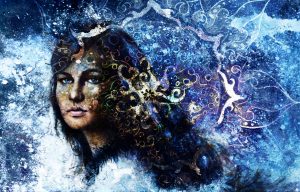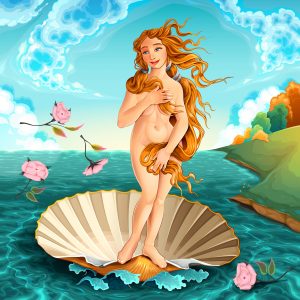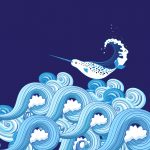
Have you ever held a shell to your ear and listened to the sound of the ocean? You can dismiss the experience as the simple and scientific vibration of blood to bone. Or you can interpret the sound as ancestral. You’ve awakened your spirit to the feminine mysteries of the sea.
This is the first of a two-part series on seashells and ocean goddesses. I begin with Sedna, Queen of the Arctic Ocean.
In cultures around the world, we find goddesses whose stories connect them with shells and treasures from the sea.

- Aphrodite, the Greek maiden goddess of love, was born from the ocean fully grown and is often depicted standing on a giant clam shell.
Salacia, the Roman goddess of the ocean, is decorated with seaweed and pearls.
Changing Woman, the Navajo goddess who, four times in life (her own birth, puberty, motherhood, and death), briefly embodies the sacred White Shell Woman, with the white shell being the cowrie, found in oceans worldwide.
In the world of myth, the words sea and ocean are often used interchangeably. In Latin, the word for the sea is mare. Coastal cultures that worshipped a mother goddess easily made connections between women and the sea, between the moon and the sea, between the sea and a woman’s monthly flow of blood. They also noticed that when the flow of blood ceased for nine months, the woman cradled an ocean in her body. From the woman’s ocean, came new life.
In honor of the sea and that sacred connection to birth, girls were named Mary, Maria, Maya, Marian and other variations. I grew up seeing statues, paintings, and holy cards of the Virgin Mary in a long, white gown under an equally long, blue robe. As a child, I never thought of blue for the sea and white for the foam. Now, the correlation is obvious.
Growing up in Tidewater, not far from Virginia Beach. I always felt sorry for my grandparents who lived in Pennsylvania and South Dakota, nowhere near an ocean. They might never see the waves or smell the salt air, hear the gulls, taste the bounty, squeal as they race from hot sand to cold surf. In contrast, their lives were all about coal and cattle.
Years later, I learned that much of the land on our planet was once covered with ocean. If you believe, like I do, that the land remembers, then it’s easy to imagine that my South Dakota cousins can hold a conch shell to their ears and really hear the ocean.
Before I explore the story of Sedna, the Inuit goddess of the Arctic Ocean, I want to let you know that the next episode will celebrate the story of Yemaya, the ocean goddess from the Yoruba culturue on the west coast of Africa.
First, a little about water itself. Physically, water covers about 71% of the earth’s surface. That includes lakes, rivers, streams, glaciers and snowfields. Of all that water, only about 2.5% is drinkable. The rest is too salty. Just that brief overview shows why water is known today as the “new gold,” why we need to conserve water and protect the oceans.
Metaphysically — as in beyond, or after, the physical — water is the element associated with emotions…especially with cleansing, forgiving, and healing.
Water represents the direction of the west, the direction where the spirit goes when the body dies — where the spirit is cleansed, forgiven, and healed. Why that association? Because the life-giving Sun sets in the west.
Picture a vivid sunset, one with bands of yellow, orange, coral, pink, purple and red…a blend of the day’s experiences…like silk ribbons spread along the western horizon. It’s easy to interpret that image as the death of the sun, a phenomenon that occurs every evening…along with the correlating resurrection of a newborn Sun in the east every morning.
Astrologically, there are three water signs: Cancer, Scorpio, and Pisces. From various astrologers, I’ve learned how these three signs are related to emotions:
- Cancer is about how you feel.
- Scorpio is about what motivates you.
- Pisces is about the way you merge with others.
You might not be born under one of those water signs, but all three are part of your natal chart. So when I talk about the mystery, myth and magic of the sea, and the rituals they inspired, don’t be surprised if you feel motivated to merge — to connect — with other like-minded women and those who magically embody both feminine and masculine, and those who courageously transition to or from the feminine.
The Goddess Within
Some women feel called to the energy of a certain Goddess. Such a calling might be inspired by cultural roots or by a vocation. For example:
Brigid is the Celtic goddess of poetry, healing, and smith-crafting. A woman with Celtic roots might be drawn to Brigid. A woman who knows nothing about her ancestry might also be drawn to Brigid, especially if the woman is a writer or a nurse or solders wire to make jewelry.
Flora is the Roman goddess of spring, of the flowers and plants — and the beauty of the female body. If you have Italian roots, you may be drawn to Flora. Regardless of your ancestry, the goddess might also inspire you if you’re a gardener or a florist or a nude model.

Sarasvati is the Hindu goddess of learning, of science and the arts. Her name means “the one who flows,” an acknowledgment of her skill with music and words. You don’t have to be of Indian descent to appreciate Sarasvati. If you’re a scientist or a musician or a public speaker, you would do well to explore her gifts.
Goddesses of Water
If you aren’t drawn to a specific goddess because of your ancestry or vocation, you might be attracted to a goddess because of her affinity with one of the four elements: earth, air, fire, or as in this episode, water.
Sedna
It’s in the frigid waters of the Arctic that we find Sedna. She is an Inuit Goddess, the Arctic Sea Woman.
There are several versions of her origin story, each one horrific. One is that she marries a handsome man who turns out to be a demon. The most familiar version of her story is that as a young woman, she was a disappointment to her father — either because she wasn’t pretty or she ate too many fish or she refused to marry any of the men he selected for her.
One day he took her out in a boat, supposedly to catch fish. Instead, he tossed her over the side. When she tried to climb back in, he cut off her fingers. Again, she tried to climb into the boat. He cut off her hands. Again, she tried to hoist herself to safety. He cut off her arms.

Betrayed by someone who was supposed to love her, Sedna fell to the depths of the ocean to a place where her human form died.
In those cold depths, beyond the last breath, Sedna didn’t disappear. She multiplied. Her fingers became seals, her hands became walruses, and her arms became whales. And she became Mistress of the Sea, often depicted as a mermaid with a multitude of sea creatures in her long black hair.
Sedna Ritual: Reframe Childhood Beliefs / Shell: Pink Mouth Murex
The ritual I created for Sedna is all about Reframing Childhood Beliefs. I think the perfect shell for this ritual is the Pink Mouth Murex. While this shell is found in the tropics, not the Arctic, the behavior of this murex carries an important lesson and fits well with Sedna’s story.

A Murex looks a little like a Conch… but they’re two different shells. The Pink Mouth Murex is a rounded, strong shell, usually white or gray with a glossy pink opening and, most significantly, blunted spines all over the body — like fingers that have had the tips chopped off. The female mollusk in the shell lays her eggs in a communal area. That group nursery can have millions of eggs, so many that a female can get trapped and die.
That knowledge might have been what inspired Michelle Hanson, author of the book Ocean Oracle: What Seashells Reveal about Our True Nature, to associate this shell with “the stranglehold that beliefs formulated in childhood can have on our lives.”
I can easily imagine that when Sedna was human, she didn’t feel loved, didn’t think she was lovable. Being rejected by her father was bad enough. Then he abandoned her. And then he tried — three times — to kill her.
Because Sedna was trapped in such a painful family dynamic, she died… More accurately, her human form died.
Her spirit was transformed and she became Mistress of the Sea. She took care of the seal, the walrus, the whale, and all the other members of her aquatic family.
Myths aren’t like movies where a storyline is wrapped up neatly. So we don’t know how Sedna’s father felt after he rejected his daughter, after she became the powerful deity loved and honored by the Inuit.
What we do know is that on November 14, 2003, a team of astronomers at the California Institute of Technology discovered a dwarf planet on the outer reaches of our solar system. She was given the name Sedna in honor of the Inuit goddess. Her story spread throughout the world.
In her role as protector of the ocean, Sedna insists that those who hunt and fish don’t pollute, that they take only what is truly needed, that every part of the animal they kill is used, that offerings are made as a sign of respect for the land and water. To ignore or disrespect her mandates is to risk starvation and devastating weather.
Sedna’s legend has inspired artists and activists worldwide to address global warming. One artist depicts her cradling a seal; another with sea creatures swimming in her hair. She’s often shown as a mermaid. A 2011 blog post by the Museum of Inuit Art features a sculpture titled “Sedna Speaks.” The artist Alec Lawson Tuckatuck depicts Sedna rising from the water as she transforms from a Narwhal whale into the Goddess of the Arctic Ocean.

As an aside, the Narwhal is often referred to as the unicorn of the ocean…the whale with a long tusk rising from the head. There’s a popular commercial on television that rejects a Narwhal seeking employment as the mascot of an insurance company. Yes, the commercial pokes fun at Narwhals. But indirectly, and unintentionally for sure, the commercial also raises awareness of Narwhals, a whale associated with Sedna. And that’s a good thing.
If what you believe about yourself comes from a painful childhood experience, you might find it helpful to learn more about the story of Sedna. Her people, the Inuit, come from the Arctic regions of Canada, Alaska, Russia, and Greenland.
It may be a while before the world is truly safe to travel in case you want to visit these parts of the world. In the meantime, explore Sedna’s world through movies and books and art. Make or purchase a piece of jewelry or home decor inspired by a seal, a walrus, a whale, a mermaid, a Narwhal, a polar bear, an iceberg.
Keep in mind that images are keys that open doors. To navigate the territory behind that door, or beneath an Arctic iceberg, especially if what lurks behind or beneath involves childhood pain, get professional help. Best thing I ever did.
The Power of Touch
To dive deeper in the meaning that Sedna’s story might hold for you, let’s look at the power of touch.
First, it’s helpful to be familiar with the chakras. Simply put, these are energy centers in the body. When a chakra is open, energy moves in and out freely. Energy coming into the heart chakra moves out of the body through the hands. That’s why touch is so important. It’s a physical expression of what’s in the heart.
To explore the power of touch, begin by paying attention to the way you touch objects. Do you grab the tv remote? Do you shove plates into the dishwasher or sink? Do you slam books? Punch pillows? If you play the piano, do your fingers pound the keys?
What energy comes from your hands when you prepare food? Do you grip a knife and chop onions with more force than precision? So you snap asparagus while gritting your teeth?
What energy do you express when you wash your face? Your body? Do you scrub as though trying to shed your skin?
Or, is your touch light as a feather, smooth as satin, gentle as rain? Do you welcome others with open arms? Do you console with a strong embrace?
What energy comes through your arms, your hands, your fingers when you touch someone you love, especially a child?
All these ways we use our fingers, hands, and arms reveal our feelings — not about a book or a pillow or an onion — but about ourselves.
Gather Items for a Sedna Ritual
- A Pink Mouth Murex shell. Don’t worry about finding the actual shell. A photo will do just fine. This murex is covered with what look like fingers that have had the tips chopped off. That’s why I chose this shell for this ritual.
- A ballpoint pen and seven pieces of Dissolvo. This is a special kind of paper that dissolves when it touches water. Each piece needs to be big enough for you to write a few words.
- A bowl large enough to hold a few ice cubes and for you to insert both of your hands at the same time.
- A container of water, enough to almost fill the bowl, a few ice cubes, a small bowl of salt, and a hand towel.
- A candle and a propane lighter or protected in a glass container and a lighter.
- A representation of seaweed that you can put on your head. You can purchase artificial seaweed from various shops on Etsy or from craft stores. You can use streamers of green paper or ribbon. I have not yet done this ritual. When I do, I plan to affix the seaweed to a headband.
Music. To create atmosphere, play ocean sounds with whale calls. Here’s a link to one of many you can find on YouTube.
Clothing: Wear something loose and flowing, like a caftan. Or wear nothing but the seaweed.
Breath: There’s a breathing technique in yoga called ujjayi. You’ll find instructions on YouTube. What’s important for you to know now is that ujjayi breath makes air vibrate in your sinus cavities and sounds like the ocean is in your head. The sensation is known to calm the vagus nerve.
I’ve been told by people who know a whole lot more about this than I do that calming the vagus nerve is important to reducing systemic inflammation in the body. Anger, and that includes the kind below the surface, the kind that festers for years, can cause inflammation. So, learning ujjayi breathing can be helpful at any time, not just for this ritual.
The Working
Make yourself comfortable in your prepared space. Take 3 deep, cleansing breaths. Science shows that deep, diaphragmatic breathing supports the lymphatic system, the body’s refuse removal system. The deep breath puts just enough pressure on the lymph nodes to eliminate toxins, making the breath literally cleansing.
Light the candle. If it’s safe to do so, turn down any other lights. The idea is to sit in shadows. Add the ice cubes to the bowl, pour in the water and, pinch by pinch, add the salt. You’re creating a symbolic ocean.
On the Dissolvo paper, write the negative beliefs you’ve had about yourself since childhood. The paper will dissolve as soon as it comes in contact with water. For now, be sure to keep the paper dry.
While sitting in semi-darkness, do ujjayi breathing for several minutes. Imagine that you are descending into the depths of the Arctic ocean. Know that Sedna is waiting for you. Don’t rush. Take whatever time you need.
When you’re ready, pick up each piece of paper. Don’t worry if it’s too dark for you to see what you’ve written. Your heart knows. Drop each one into the bowl of icy water. Watch the paper dissolve into a milky stream.
With empathy for the pain of betrayal Sedna felt, emerse your fingers, your hands, and a bit of your arms into the water. Ask that Sedna transform your pain.
Repeat the ujjayi breathing as you imagine yourself rising through the icy water, lighter now that Sedna has dissolved your old beliefs. No need to linger if the water is uncomfortably cold. This step is symbolic.
Withdraw your arms, your hands, your fingers. Dry yourself on the towel.
For as long as you need to, reflect on the way your mind has shifted, even if the shift is minute. Or, affirm that you are open to feeling such a shift even if it takes considerably more time.
From now on, be mindful of how you touch things and pets and other people, and yourself.
Of course, one of the best ways we can help ourselves is to help others. As you clear your ritual space and put away the tools of your personal magic, think about ways you can help Sedna protect the Arctic ocean.
The Arctic is warming twice as fast as the rest of the world. To learn more, check out the program “Protecting the Arctic” at the Ocean Conservancy. https://oceanconservancy.org/protecting-the-arctic/
Simple Ritual Bath
If the Sedna ritual feels too intricate, you can take a ritual bath. Before you step into the water, add a few ice cubes and a pinch of salt. Imagine that you’re stepping into the Arctic ocean. You can still play ocean sounds and whale calls. You can still reflect on how Sedna turned pain into power. You can still feel the power of the Goddess of the Arctic Ocean.
Being aware of the myth and magic of the oceans of the world is one step in helping each of us do our part to conserve water. We aren’t the only kind of life that depends on the health of our oceans.

